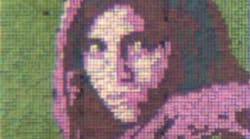Nanoscale-structured surface enables 127,000 DPI laser printing
Using a new nanoscale plasmonic printing technology, Technical University of Denmark (DTU) researchers from DTU Nanotech and DTU Fotonik (both in Lyngby, Denmark) have reproduced a color image of Mona Lisa that is less than one pixel on an iPhone Retina display. The laser technology allows printing in a mind-blowing resolution of 127,000 DPI. In comparison, weekly or monthly magazines are normally printed in a resolution equivalent to 300 DPI. This breakthrough in nanotechnology printing is published in the scientific journal Nature Nanotechnology.
Related Article
Printing the microscopic images requires a special nanoscale-structured surface. The structure consists of rows with small columns with a diameter of merely 100 nm each. This structured surface is then covered by 20 nm of aluminum. When a laser pulse is transmitted from nanocolumn to nanocolumn, the nanocolumn is heated locally, after which it melts and is deformed. The temperature can reach up to 1500°C, but only for a few nanoseconds, preventing the extreme heat from spreading.
The intensity of the laser beam determines which colors are printed on the surface, since the extent of column deformation decides which color is reflected. Low-intensity laser pulses lead to a minor deformation of the nanocolumn, resulting in blue and purple color tone reflections. Strong laser pulses create a drastic deformation, which gives the reflection from the nanocolumn an orange and yellow color tone.
Professor Anders Kristensen from DTU Nanotech says, "It will be possible to save data invisible to the naked eye. This includes serial numbers or bar codes of products and other information. The technology can also be used to combat fraud and forgery, as the products will be labelled in way that makes them very difficult to reproduce. It will be easier to determine whether the product is an original or a copy."
The new laser printing technology can also be used on a larger scale to personify products such as mobile phones with unique decorations or names, for example. Foreign companies producing parts for cars, such as instrument panels and buttons, are already taking a keen interest in the technology as it can simplify the production. Today, the large number of different instrument panels must be adapted to the various accessories that the car has, including air conditioning, USB, and cigarette lighters, among others.
The technology has been patented, and the researchers will now focus on developing the technology, so that it can replace the conventional laser printers that we have at our offices and in our homes.
SOURCE: Technical University of Denmark; http://www.dtu.dk/english/News/Nyhed?id=e2829943-7649-4946-a231-4c3169320ea3&

Gail Overton | Senior Editor (2004-2020)
Gail has more than 30 years of engineering, marketing, product management, and editorial experience in the photonics and optical communications industry. Before joining the staff at Laser Focus World in 2004, she held many product management and product marketing roles in the fiber-optics industry, most notably at Hughes (El Segundo, CA), GTE Labs (Waltham, MA), Corning (Corning, NY), Photon Kinetics (Beaverton, OR), and Newport Corporation (Irvine, CA). During her marketing career, Gail published articles in WDM Solutions and Sensors magazine and traveled internationally to conduct product and sales training. Gail received her BS degree in physics, with an emphasis in optics, from San Diego State University in San Diego, CA in May 1986.

